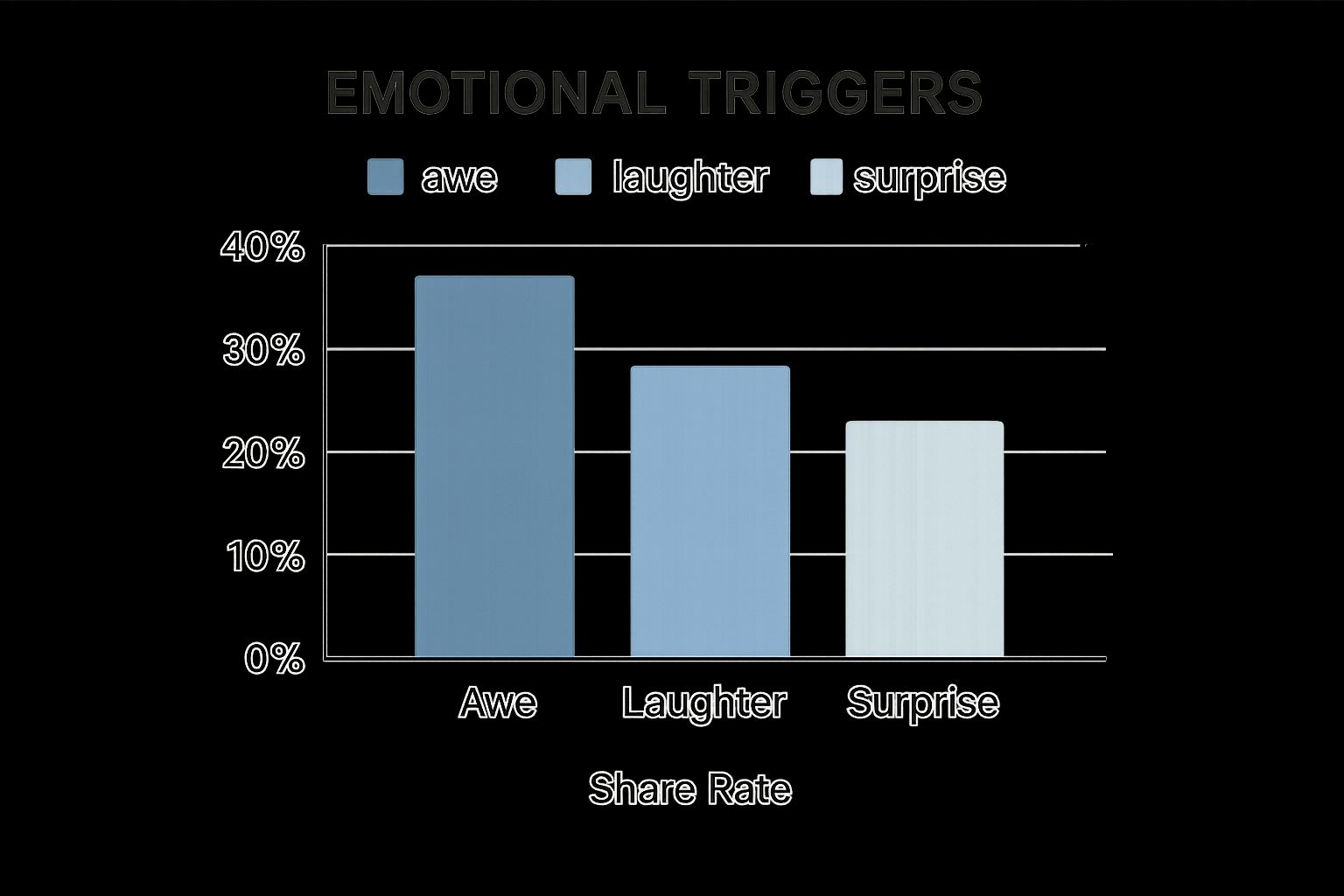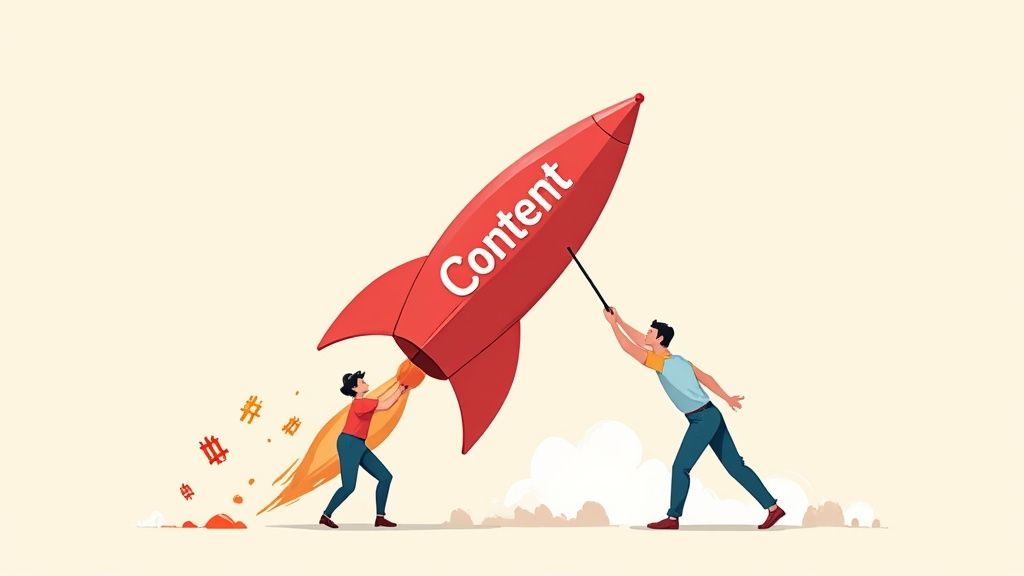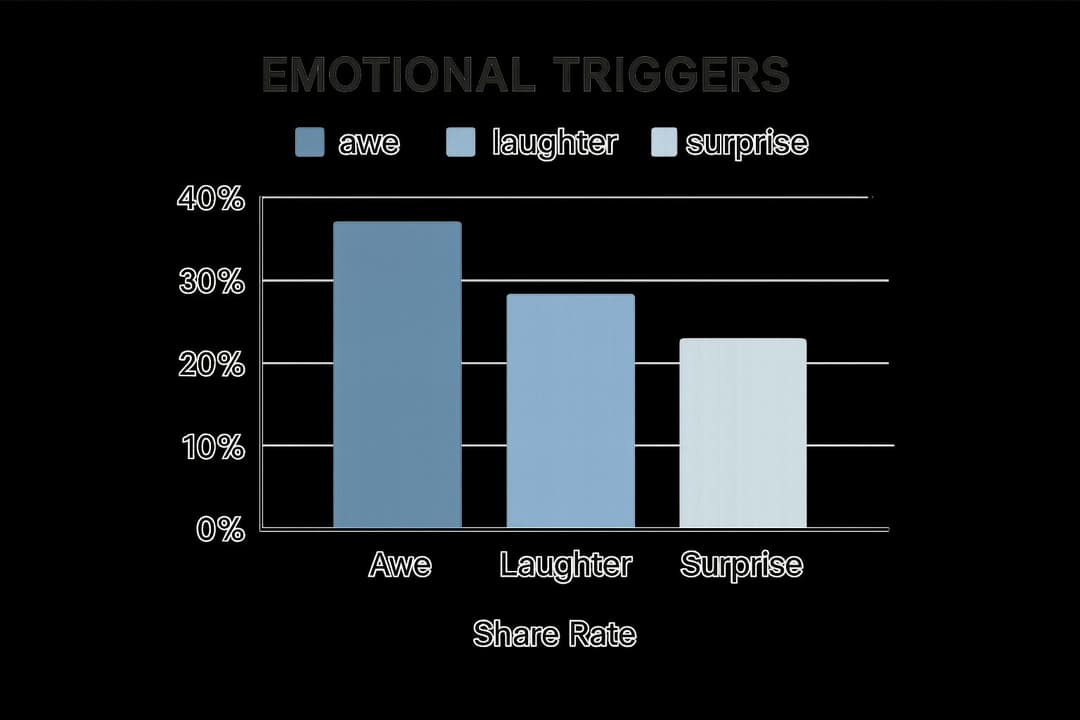Ever wonder why a simple cat video gets millions of views while your carefully crafted post gets crickets? It's not about luck or a massive budget. The secret lies in human psychology.
The difference between a post that flops and one that soars comes down to one thing: emotion.
Why Some Content Explodes and Others Don't
Viral content gets into our heads. It hits a nerve. When we see something that makes us feel a powerful emotion, our first instinct is often to share it. Sharing is how we connect with others and say, "Hey, you've got to see this!"
It's the high-energy emotions that really get people clicking the share button. Think about it—the content that spreads like wildfire is rarely the stuff that’s just “nice.” It’s the content that sparks excitement, action, and a genuine reaction.
The Power of Emotional Triggers
Think about the last video that made you laugh until you cried, or a story that left you speechless. Those weren't just random acts of content. They were perfectly packaged emotional experiences designed to make you feel something. That’s the real goal here.
Time and time again, research shows that a few key emotions are absolute powerhouses for driving shares.
- Awe: Content that makes you say "whoa." Think stunning drone footage of a mountain range or a story of incredible human kindness. It makes us feel like we're part of something bigger.
- Laughter: Humor is the ultimate icebreaker. If you can make someone genuinely laugh, they'll want to pass that good feeling along to their friends.
- Surprise: Did you know that otters hold hands when they sleep? Shocking facts, plot twists, and myth-busting content grab our attention and make us feel smart for sharing.
This chart breaks down just how effective these emotions are at getting people to share.

As you can see, content that inspires awe has a huge impact, but laughter is right behind it. Surprise is a strong contender, too.
Unlocking Social Currency
Beyond just pure emotion, there's another powerful driver at play: social currency. People share things that make them look good. It's that simple. They want to look smart, funny, cool, or in-the-know.
Before you hit publish, always ask yourself this question: "Does sharing this make my audience look good to their friends?" If the answer is a resounding yes, you've got a winner.
When someone shares a fascinating "did you know?" fact, they look intelligent. When they share a hilarious meme, they look like the funny one in their group chat. Your content becomes a shortcut for them to build their own reputation.
Once you grasp this, you stop just making posts. You start designing shareable experiences that your audience can't wait to pass on for you.
Mastering the Unwritten Rules of Each Platform

Let's be real. A hilarious, fast-paced video that kills it on TikTok would feel completely bizarre on a professional LinkedIn feed. I've seen countless brands make the mistake of copy-pasting the same content everywhere, and it’s one of the fastest ways to make sure it flops.
Every social platform is its own little world, complete with unique rules, trends, and audience expectations. You have to get this right.
It’s not about being on every single platform; it's about mastering the ones where your audience actually lives. And for most of us today, that means getting really, really good at short-form video.
The Reign of Short-Form Video
Platforms like TikTok, Instagram Reels, and YouTube Shorts have completely changed the game. They’ve trained us to want quick, engaging, and super-digestible clips that get straight to the point. This isn’t just some fleeting trend—it's now the dominant force in social media.
The sheer volume of content is mind-boggling. As of 2025, creators are uploading something like 720,000 hours of video content every single day. If you want to dive deeper into the numbers, Talkwalker's latest report has some great insights.
In a space that crowded, your biggest advantage is knowing the specific nuances of each platform's video style.
Viral content isn’t a one-size-fits-all deal. It’s custom-built for a specific audience on a specific platform, speaking their language and fitting seamlessly into their feed.
To give you a clearer picture, I've put together this quick-reference table. It breaks down what makes each platform tick when it comes to creating content that people actually want to share.
Key Platform Characteristics for Viral Content
| Platform | Optimal Content Format | Key Audience Demographic | Virality Driver |
|---|---|---|---|
| TikTok | Raw, unpolished, trend-driven short videos (15-60s) | Gen Z & Young Millennials (16-34) | Trending sounds, memes, challenges, authenticity |
| High-quality, aesthetic Reels; polished Stories & Carousels | Broad Millennial & Gen Z audience (18-45) | Visual appeal, inspirational stories, quick tutorials | |
| YouTube | Long-form educational/entertaining videos; Shorts for hooks | Wide range, leans towards 18-49 seeking info/entertainment | Value, storytelling, searchability (solving a problem) |
| X (Twitter) | Short text, memes, quick video clips, real-time updates | News junkies, professionals, tech-savvy users (25-50) | Timeliness, wit, controversy, conversational engagement |
| Professional text posts, simple videos, articles, carousels | Professionals, B2B audiences, job seekers (30-55+) | Industry insights, career advice, success stories, data |
Understanding these distinctions is the first step. The goal isn't to be a different person on each platform, but to adapt your delivery to fit the room.
Adapting Your Content Style
So, how does this look in practice? Even if your core idea is the same, the execution has to change. Think of it like a musician playing the same song in different genres—a rock anthem can become a quiet acoustic melody.
Here’s a quick breakdown from my experience:
- TikTok: This is the land of raw and real. Don't overproduce it. Seriously. A slightly chaotic, unpolished feel often does best. Jump on trending sounds and meme formats as soon as you see them.
- Instagram Reels: This one leans a bit more polished and aesthetic. High-quality visuals, inspirational stories, and quick, beautiful tutorials do exceptionally well here. It’s the perfect spot for visually appealing "how-to" content.
- YouTube Shorts: The audience here is often looking for direct value or a quick dose of entertainment. Think life hacks, fascinating facts, or condensed versions of your longer educational videos. Shorts are a fantastic gateway to your main channel.
Using Social Listening to Spot Trends Early
If you want to create viral content consistently, you have to know what people are talking about right now. This is where social listening comes into play. It’s more than just mindlessly scrolling your feed; it’s about actively monitoring conversations, keywords, and emerging sounds in your niche.
Using a tool like Postiz helps you keep an ear to the ground and spot trends before they're everywhere. When you see a new sound or challenge picking up steam, you can jump on it fast. This makes your content feel timely and relevant, which is a massive signal to the algorithm that you know what its users want to see.
This is how you play the game smarter, not harder.
Let AI Help You Find Viral Gold

Look, that lightning-in-a-bottle viral idea rarely comes out of thin air. Most of the time, it feels like that, but behind the scenes, there's a method to the madness. Instead of waiting for inspiration to strike, you can use AI as a creative partner to systematically dig up ideas that actually have a shot at taking off.
Think of it this way: AI gives your creativity a data-backed launchpad. You're not just guessing what might work; you're starting with a solid foundation based on what already resonates with people. It's like having a research assistant who’s online 24/7, tracking trends and figuring out what makes your audience tick.
Pinpoint Your Competitors’ Blind Spots
One of the smartest ways to start is by looking at what everyone else is doing—and, more importantly, what they're not doing. This is where AI really shines.
You can pop a few of your competitors' social media accounts into an AI assistant, like the one built into Postiz. In seconds, it can scan their best-performing posts and pull out the common themes, formats, and emotional hooks they're using. But the real magic is finding the gaps.
I love asking the AI this simple question: "Looking at these successful posts, what topics or formats are they completely ignoring?" The answer is often a content goldmine—an idea your audience craves that no one is delivering.
This approach lets you swerve when everyone else is sticking to the same lane, making your content feel fresh and original right from the start.
Brainstorm Angles, Not Just Topics
Once you've found a promising gap, it's time to get specific. A broad topic like "productivity tips" is a guaranteed snooze-fest. An AI can help you shatter that boring topic into a dozen unique, scroll-stopping hooks.
Instead of one bland idea, you can instantly generate a whole cluster of content possibilities. Try giving the AI prompts like these:
- "Give me 10 controversial takes on productivity for a TikTok video."
- "List 5 surprising 'did you know?' facts about time management."
- "Write 3 relatable short stories about procrastination from the perspective of a busy parent."
Suddenly, you have a rich pool of concepts you can test and run with. If you're curious about how these tools work under the hood, we have a complete guide to AI content generation tools. For a really deep dive into one of the popular options, this Jasper AI review is a fantastic resource for understanding its creative capabilities.
At the end of the day, using AI isn't about letting a robot take over. It’s about sharpening your creative instincts with some seriously powerful data.
Crafting Unskippable Short-Form Videos
https://www.youtube.com/embed/t5Z-Q1bg1tU
In the world of endless scrolling, you don't have minutes to make an impression—you have less than three seconds. That’s it. If you want to create content that actually goes somewhere, especially video, you have to win that initial battle for attention before the user's thumb even thinks about swiping away.
The secret is to front-load your value. Don't build up to a punchline or save your best tip for the last five seconds. Your very first frame or spoken word has to be a powerful hook that stops a viewer dead in their tracks and makes them wonder, "Okay, what's this about?"
This immediate payoff isn't just a nice-to-have; it's essential. The way people consume content has completely changed. Research shows that a whopping 73% of consumers actually prefer short-form videos when learning about products or services. Not only that, but these bite-sized videos generate 2.5 times more engagement than their longer cousins. The numbers don't lie—this format is where the action is.
The Anatomy of a Viral Short Video
So, what’s the formula for a video people actually finish watching? It boils down to a few key ingredients that work together to hold attention from the first second to the last. Forget about fancy, high-budget production; just focus on getting these pillars right.
- A Killer Hook: Kick things off with a controversial statement, a surprising visual, or a question that piques instant curiosity.
- Rapid Pacing: Think quick cuts, dynamic text on screen, and a story that moves fast. Dead air is the enemy. Avoid any moment where nothing is happening.
- Trending Audio: Using a popular sound is like a shortcut to relevance. It instantly taps into a wider conversation and gives the algorithm a reason to show your video to more people.
Your goal isn't just to get one view; it's to get someone to re-watch. When a video is packed with quick-fire information or a subtle joke, people often watch it two or three times. That’s a massive signal to the algorithm that you’ve made something worth sharing.
Storytelling in Under 60 Seconds
You don't need a Hollywood script to tell a compelling story. In short-form video, the simplest frameworks are often the most effective.
The "problem-solution" format, for example, is a classic for a reason. Show a common, relatable frustration in the first few seconds, then immediately present your unique solution. This works for everything from cooking hacks to marketing advice. Another powerhouse is the "transformation" video, which gives viewers a satisfying before-and-after payoff.
And don't forget: many people watch videos with the sound off. Use bold, easy-to-read captions and text overlays to carry your message visually. Make sure your video is optimized for its platform by using the right aspect ratio; our guide on vertical video dimensions will help you nail this every time. When your content is accessible and visually engaging, you create an unskippable experience that works with or without sound.
Giving Your Content That First Push

Look, creating a video you think could go viral is only half the work. Hitting "publish" and just hoping it takes off is a classic mistake. I’ve seen it a thousand times—amazing content that goes nowhere because it never got that initial nudge.
Even the best stuff needs a little help to get seen. Think of it like starting a domino rally. Your job is to tip that first domino, giving it just enough momentum to start a chain reaction.
Tap Into Real Communities
One of the smartest ways to get that initial traction is by working with creators who already have your target audience's ear. And no, this doesn't mean you need a five-figure budget for a celebrity influencer. In fact, that's often the wrong move entirely.
The real magic is with micro-influencers. These are creators with smaller, but incredibly dedicated, followings. Their audience hangs on their every word because they feel like a trusted friend, not a walking billboard.
An authentic endorsement from a respected voice in a niche community is far more powerful than a paid shoutout from a disconnected mega-influencer. Find the people whose audience would genuinely love what you’ve made.
The numbers back this up. Influencer marketing isn't just hype; it delivers an average ROI of $5.78 for every dollar spent. Micro-influencers are especially potent, boasting an engagement rate of 3.86% on Instagram, which crushes the 1.21% seen by their macro-influencer counterparts. With 61% of people now trusting influencers more than brand ads, the writing's on the wall. If you want to dive deeper, there are plenty of social media marketing statistics that paint a clear picture.
Build Your Own Momentum
Collaborations are great, but what you do on your own channels is just as critical. You can't just post it and forget it. You have to be an active participant in the conversation.
Here's how to get started:
- Be a Hashtag Master: Stop using generic tags like
#viral. Instead, use a smart mix of broad, niche, and community-specific hashtags. They act like little road signs, guiding the perfect viewers right to your video. - Show Up Where Your People Are: Find the online hangouts where your content would be genuinely appreciated. Maybe it's a specific Subreddit, a buzzing Facebook group, or a niche forum. Share your work there as a helpful contribution, not a spammy ad.
- Spark Immediate Interaction: End your caption with a question or a clear call to action. Prompting comments right away signals to the algorithm that people are interested, which can give your post a massive boost.
These first steps are everything. To get a more detailed playbook on this, check out our guide on effective content distribution strategies. By giving your content a calculated first push, you set the stage for it to catch fire and spread all on its own.
Turning Viral Moments into a Repeatable System
That feeling when a post goes viral? It's electric. But if you can't figure out why it took off, it's nothing more than a lucky break. The real magic happens when you can turn that lightning in a bottle into a repeatable process. This is where you stop chasing trends and start building a real strategy—one fueled by your own data.
A lot of people get hung up on vanity metrics. Sure, a mountain of likes and views feels great, but those numbers don't tell you the whole story. To really get what makes your content connect, you have to dig into the metrics that show genuine interest and impact.
Look Beyond the Surface-Level Data
Instead of just celebrating a high view count, it's time to focus on the analytics that actually reveal how your audience behaves. These are the numbers that hand you the keys to making viral content again and again.
- Share Rate: This is your golden metric, plain and simple. When someone shares your content, they're giving it their personal stamp of approval. A high share rate is the purest sign of virality.
- Audience Retention: How long are people sticking around? If you see a huge drop-off in the first three seconds, your hook isn't landing. High retention, on the other hand, means you've got them captivated.
- Comment Analysis: Don't just count the comments—read them. Are people tagging friends? Asking genuine questions? Sharing their own experiences? The quality of the conversation is a goldmine of insight.
Postiz’s analytics dashboard brings all of this information to the forefront, making it dead simple to spot the patterns that matter.
Here's a glimpse of what you'll find in the analytics dashboard to keep an eye on your content's success.
This view lets you quickly see which posts are crushing it, so you can pinpoint the formats and topics driving real, meaningful engagement.
The secret to consistency isn't just making more content; it's understanding the content you've already made. Your best-performing posts are the blueprint for what your audience wants to see next.
Start looking for the common threads in your wins. Was it a specific video format? A certain style of humor? An emotional trigger you tapped into? That's how you build a framework and take the guesswork out of creation. To truly scale your viral content and ensure it delivers real results, think about how performance marketing principles can help you measure and optimize your strategy. It’s all about building a content engine that runs on a deep understanding of your audience, not just luck.
Got Questions? Let's Get Them Answered
You've got the framework down, but let's be real—questions always come up. Here are some quick, no-nonsense answers to the things people usually ask when they're trying to crack the viral code.
How Long Does It Take for Content to Go Viral?
This is the million-dollar question, and the honest answer is: there's no set timeline. I've seen posts catch fire within an hour, while others simmer for days before suddenly taking off. Sometimes, an algorithm will even dig up an old post and give it a second life because it aligns with a new trend.
That said, the first 24 hours are incredibly important. This is your window to build that initial buzz. The platforms are watching closely during this time, using early engagement signals like shares and comments to decide if your content is worth pushing to a bigger audience.
Can My Boring B2B Company Actually Go Viral?
Yes! It’s a common myth that only B2C brands with flashy products can go viral. The truth is, any business can do it if you find the right angle.
Virality isn't about what you sell; it's about the story you tell. A B2B software company can go viral by showcasing a funny behind-the-scenes moment or creating a relatable meme about office life.
Think about it. You can share incredible industry insights, create genuinely helpful educational content, or just use a bit of humor to show off your company culture. It all boils down to connecting with people on a human level or offering something so valuable they can't ignore it.
If You Had to Pick One Thing, What’s the Most Important Factor for Virality?
If I had to strip it all down to one core element, it’s the impulse to share. Viral content is something that people feel an almost physical need to send to a friend, a coworker, or their family. It’s a gut reaction.
What triggers that reaction? It's almost always one of these three things:
- A powerful emotional hook (laughter, awe, shock, or inspiration).
- Social currency (sharing it makes someone look cool, smart, or in-the-know).
- Massive practical value (it offers a brilliant solution to a common problem).
Before you hit publish, ask yourself this simple question: "Why would someone feel compelled to show this to another person?" If you have a solid answer, you're on the right track.
Ready to put all this into practice? Postiz has the AI brainstorming tools, easy-to-use scheduling, and powerful analytics to help you build, manage, and measure your next big hit. Start building your repeatable system today.





